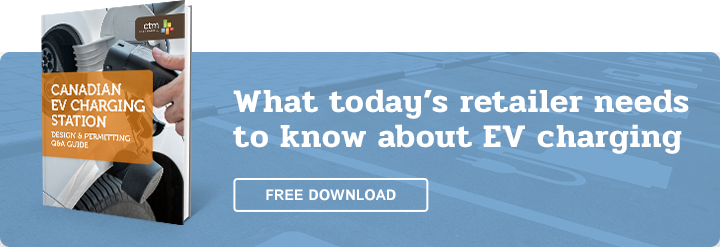12:45 pm
What Is Range Anxiety? And Why Does It Make Ev Charging Stations More Attractive to Retailers?

By Ryan Guanlao, Business Development Director, CTM Design
Electric vehicle (EV) charging stations is a topic I can speak to all day. And not just because our company provides the retail engineering and design services required to install them.
I’m also an electric vehicle owner.
So, what is an EV owner’s greatest fear?
Like many (if not most) electric vehicle owners, I suffer from an affliction commonly known as ‘range anxiety’.
Range anxiety is a fear of being caught between charging stations with a dead battery.
It’s why EV owners always feel most comfortable driving on a full charge – and not tempting fate.
My electric car gets about 400 km on a charge. It sounds like a lot, but if I’m running around the city it can add up. Between shuttling kids to school, work meetings, evening activities – there are days I can put on close to 400 km. For me, the goal is to stay charged without interrupting my daily routine.
So, even if I’m going just a short distance – say a family trip from Calgary to Canmore (an hour away) – I’ll religiously stop to charge up my vehicle. Whether it needs it or not.
In this amazing mountain town, there is a Tesla Supercharger station I always visit. It can fully charge my battery in about 45 minutes.
Best of all, it just happens to be located next to a Boston Pizza and a Dairy Queen. Which is perfect! The kids get a chance to rest from all that mountain activity, and by the time we’re done – we have full bellies and a full charge!
And the charging station is a big reason EV drivers frequently use these businesses over the countless of other great restaurants in the area.
Corporate businesses with higher dwell times are ideal locations.

Based on current charge times, EV charging stations are ideally suited for businesses where people can easily kill 30 minutes to an hour shopping, eating…even getting a haircut.
Because there are a limited (but growing) number of public charging stations, businesses that have them are like a magnet to us EV drivers.
Governments, shopping malls, private charging network providers, large chain retailers and corporate service providers (eg. banks) are ‘leading the charge’, so to speak.
For them, the investment in green technology goes beyond simply dollars and cents. It aligns with greater goals around sustainability policy and ESG commitments driven by the investor community.
Given the current price of installing an EV charger, it is generally cost-prohibitive for most independently-owned businesses. It would take most a long time to see a return on investment. Soon, that will change as EV adoption increases and the economics make more sense.
Canadian retailers are among those jumping on board
As I write, there are 6,962 public charging stations across Canada. That’s an increase of 15.7% since April 2021.
Of these, 2,847 are DC Fast Charging stations which are capable of delivering a full charge in less than an hour.
Canadian Tire is just one
national retailer that is installing EV charging stations to promote their
sustainability initiatives, with the added bonus of increasing dwell times.
In January 2020, they announced a $5M investment (backed by $2.7M in funding from Natural
Resources Canada). The plan is to bring DC Fast Chargers and Level 2 chargers
to 90 of its locations, working with several suppliers, including FLO, Tesla
and Electrify Canada. It will make Canadian Tire one of the largest charging
networks in the country.
What about convenience stores and gas stations?
7-Eleven announced plans earlier this summer to add at least 500 chargers to 250 stores across the U.S. and Canada by the end of 2022.
They have stated their corporate commitment to accelerating the adoption of EVs and alternative fuels.
While I wouldn’t be surprised if these convenience stores were strategically located near restaurants and businesses with longer dwell times… I suspect there is substantial research indicating it will also help boost in-store sales of drinks, snacks and other convenience items among a new generation of drivers.
Drivers like me who don’t like tempting fate by ‘running close to empty’. Be it their EVs or their tummies.
